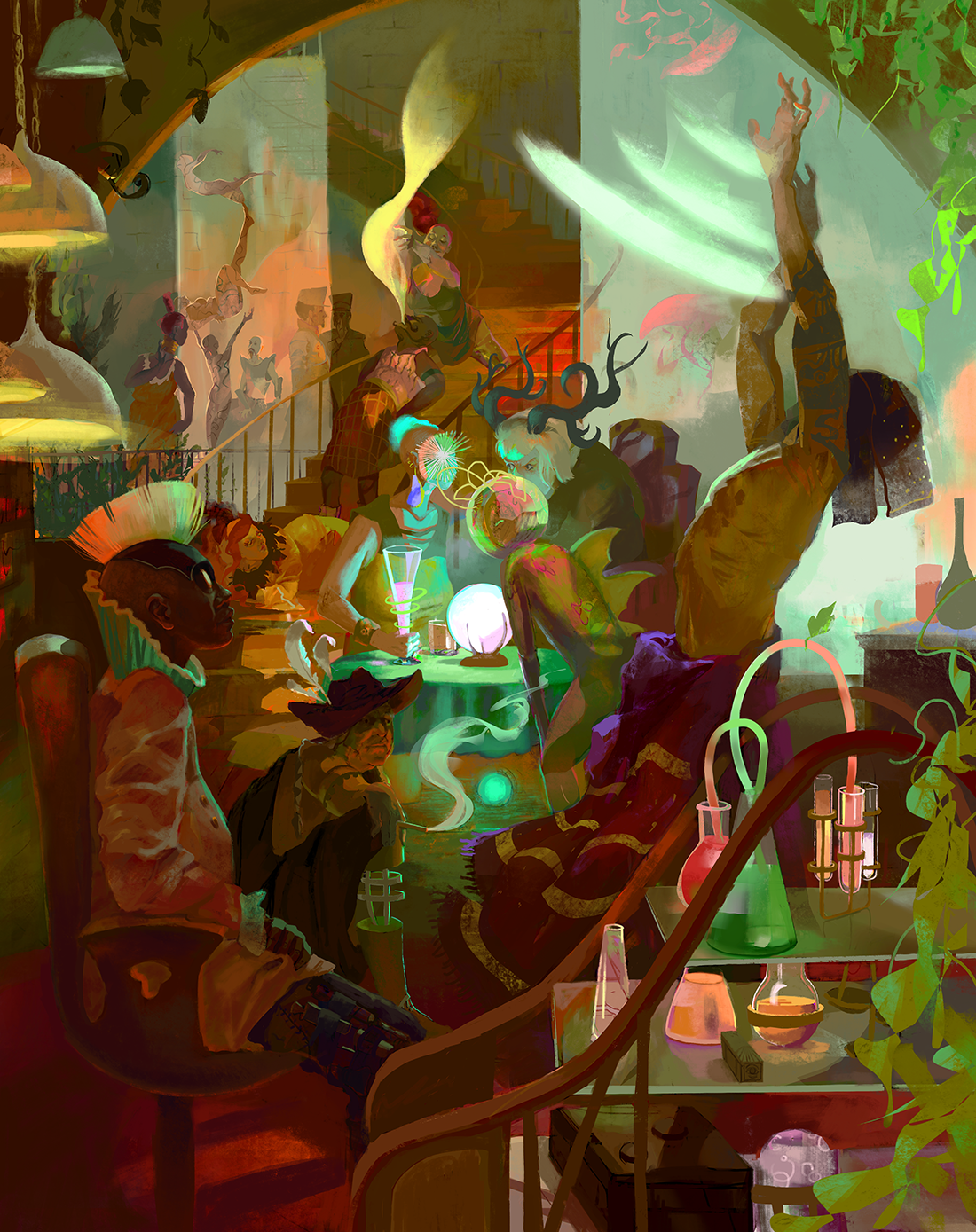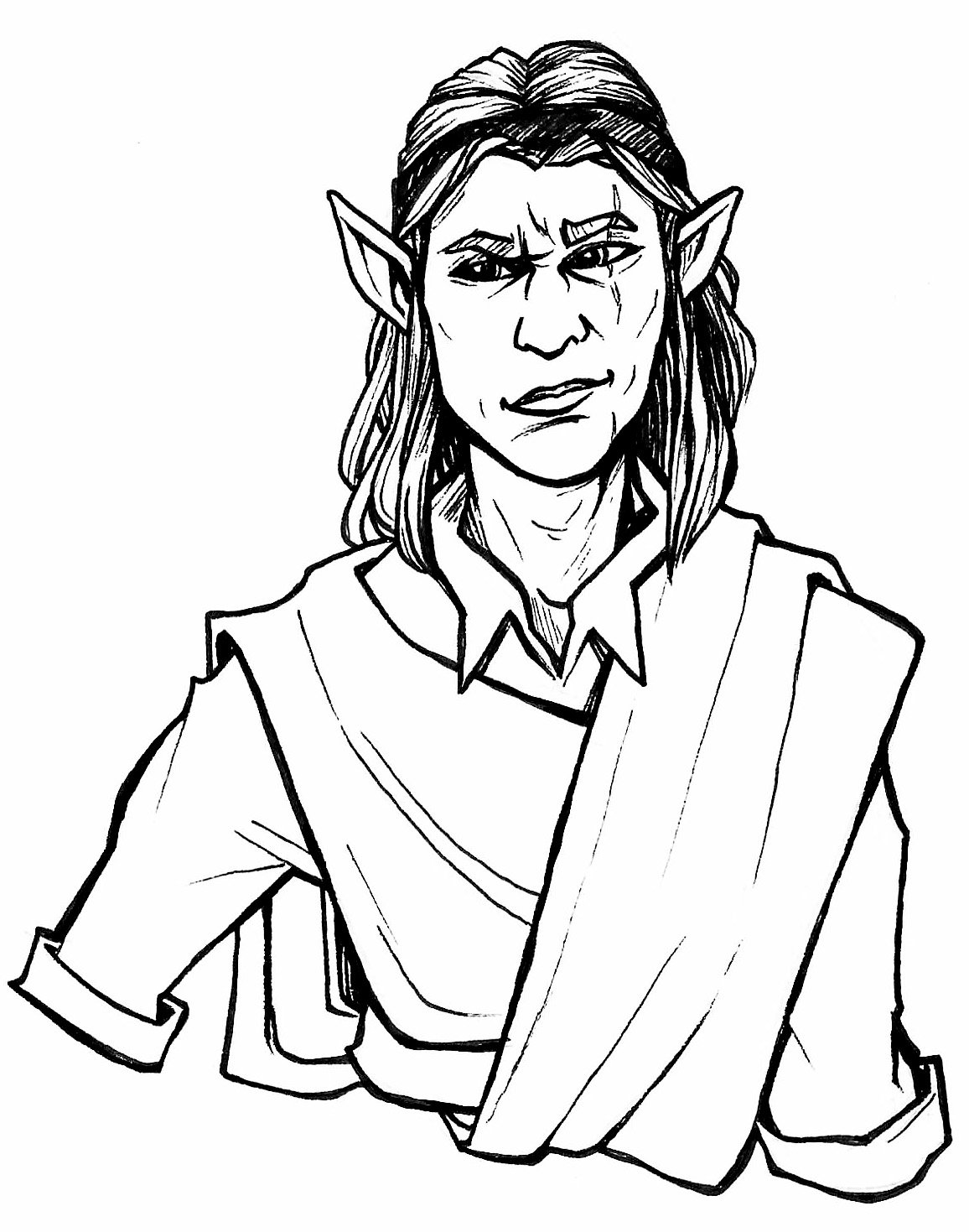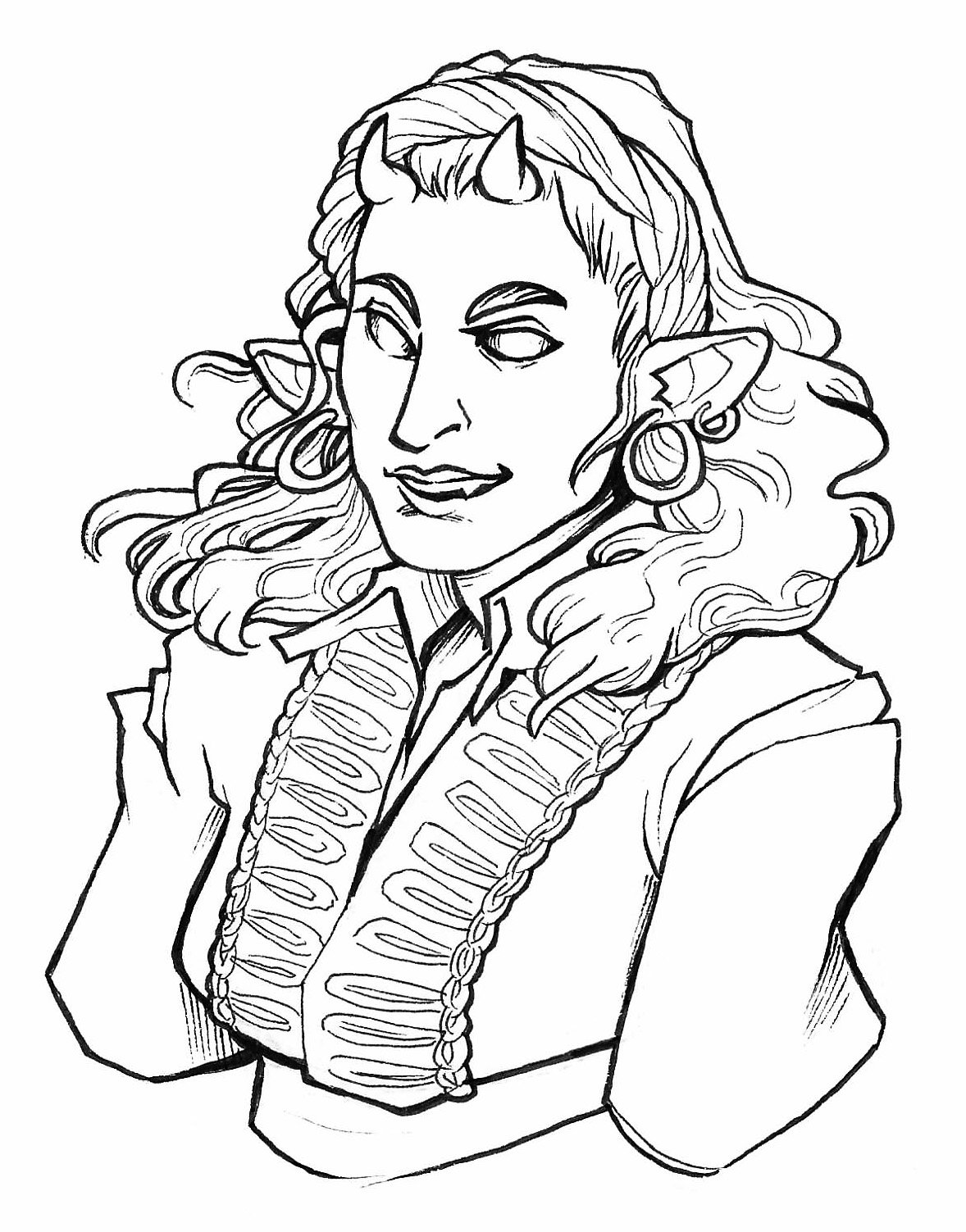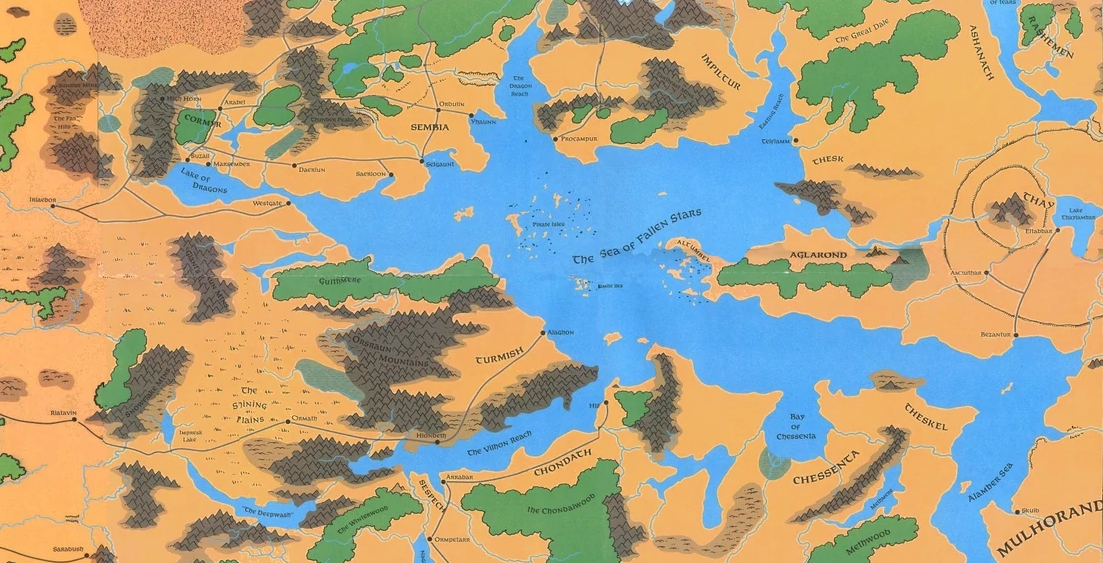
Go to Part 1
Now that we’ve looked at what vaguely passes for continuity in Descent Into Avernus, let’s look at what preceded it.
The first thing to note is that Zariel was not previously involved in the famous Charge of the Hellriders. Variants in that continuity are covered in more depth as part of the Textual History of Elturel, but the short version is that:
- The Charge was originally an almost legendary event in 1358 DR (which makes it unlikely that it happened in 1354 DR).
- The original explanation for the Charge was that the knights were riding to rescue a companion.
- This was later changed to “long ago warriors of Elturel literally rode through a gate into the Nine Hells to pursue and destroy devils that had been plaguing the people.”
You can see how, in Descent Into Avernus, this was changed again to something between “holy crusade that was the whole reason they had signed up in the first place” and “pursuing and destroying DEMONS that had been plaguing their people.”
TIAMAT, THE LORD OF AVERNUS (1977)
Way back in 1977, the original Monster Manual said that “Tiamat rules the first plane of the Nine Hells where she spawns all evil dragonkind.”
In the Manual of the Planes (1987), we are told that, “The watchdog of the Hells’ front parlor is Tiamat.”
In Monster Mythology (1992), Tiamat “infests the uppermost of the Nine Hells with her consorts, each a Great Wyrm of a different color — one red, one white, one green, one blue, and one black.” (These consorts are an evolution of Tiamat’s “guard” in Supplement I: Greyhawk (1975), when she was merely the Dragon Queen and her “major abode is in a stupendous cavern far beneath the earth.”)
We’re also told in Monster Mythology that Tiamat’s “relations with the baatezu [devils] that populate the Hells and stray into her realm at times is the subject of considerable speculation by sages.” (Which is basically the author, the esteemed Carl Sargent, saying, “I’m really trying to figure out why the evil Dragon Queen is in charge of Avernus.”) These “sages” have traditionally said that she’s been at war with the devils, but now it seems that the devils may be seeking to make some sort of pact with her to aid them in the Blood War.
PLANESCAPE: PLANES OF LAW (1995)
In Planescape: Planes of Law we are told that there are giant fireballs that just randomly appear around Avernus for no apparent reason. “Some sages say the fireballs represent the will of the nameless archduke of the level.” (emphasis added)
“Speaking of the archduke: Bel, the pit-fiend commander of the armies of this layer, leads immense legions across the plane, scouring every inch of it for invaders and searching for honors from the archduke.” Bel has “been appointed by the Dark Eight” and is the senior general of Avernus (with other generals “bowing to Bel’s experience and political muscle.”)
This is the first reference to an Archduke of Avernus. But if they’re nameless, what happened to Tiamat?
“Tiamat, the Lady of Dragonkind, guards the only known entrance to the next layer. It’s only through her lair that one can arrive in the verdigrised plains near the Iron City of Dis.”
Note: I’m pretty confident that “watchdog of the Hells’ front parlor” in the Manual of the Planes was just a poetic rephrasing of “Tiamat rules the first plane of the Nine Hells” from the original Monster Manual. Here, however, the meaning has glided towards guarding a literal “front parlor;” i.e., the path to Dis.
DRAGON #223 – THE LORDS OF THE NINE (1995)
Planes of Law came out in February 1995. As noted, it included Bel as a general and left all but three of the Lords of the Nine mysterious and unknown. This, it should be noted, was a diegetic mystery — it’s not just that TSR wasn’t telling you; it was that their identities were a mystery to the characters in the game world itself.
But in the November 1995 issue of Dragon Magazine (#223, which would have been released in August 1995), Colin McComb writes “The Lords of the Nine”: “The Lords of the Nine Layers of Baator have been revealed at last! Do you dare to read about them?”
And, indeed, McComb provides identities for all nine archdukes. And this is done diegetically. A character named Willgan the Dogged has discovered their identities and is ready to tell all!
Note: I belabor this mostly because I’m fascinated by the decision process to drop this entire aspect of the Planescape setting almost immediately after publishing the boxed set.
Regarding Bel, we are told, that “the original Lord of Avernus (not Tiamat, contrary to popular belief) found herself imprisoned and entrapped by her warlord, the pit fiend Bel, thousands of years ago.” Bel is siphoning more of the Lord’s power for himself, but is still beholden to the Dark Eight.
GUIDE TO HELL (1999)
Chris Pramas’ Guide to Hell is Zariel’s first named appearance. She is described as the “original Lord of Avernus.”
Pramas also described the Reckoning: A great war in Hell which started when Zariel laid siege to Dis. Her allies – Moloch and Belial – simultaneously launched an assault on Stygia. Mephistopheles eventually broke the siege on Dis, forcing Zariel back to Avernus. The final battle was to be fought in Maladomini (the seventh layer of Hell), but Asmodeus pulled a coup: Geryon, Lord of Stygia, had suborned the generals of the other Lords’ armies. On the day of the ultimate battle, the generals mutinied, declared their loyalty to Asmodeus, and ended the war. Bizarrely, only Geryon – the only Lord to remain loyal to Asmodeus – was subsequently ousted from his position of power.
The generals, however, were empowered as the newly created Dark Eight. This council runs the Blood War from Nessus, the lowest level of Hell.
The pit fiend Bel, after running successful covert ops missions during the Blood War under the command of the Dark Eight, became Zariel’s right-hand man in Avernus. He then betrayed and imprisoned her, rendering her powerless.
Note: Describing Zariel as the “original Lord of Avernus” might seem in direct contradiction to Tiamat having held that position before. This is most likely intended as a straight-up retcon, but it doesn’t necessarily have to be so: My head canon is that Zariel, the original Lord of Avernus, has been intermittently deposed from time to time over the course of long eons, including stints by both Tiamat and Bel.
MANUAL OF THE PLANES (3rd EDITION, 2001)
The references to Avernus in the Manual of the Planes are largely a very short summary of the material from Guide to Hell, but there’s one addition to the mythology: “Bel still keeps Zariel prisoner somewhere deep in the Bronze Citadel so that he can siphon her hellish power to himself, increasing his own abilities while slowly reducing her to just another soul shell.”
This is repeated in the Book of Vile Darkness (2002), where Zariel is kept in the Bronze Citadel where Bel “draws off her power to extend his own.”
FIENDISH CODEX II (2006)
Fiendish Codex II: Tyrants of the Nine Hells largely reiterates the continuity from Guide to Hell (in a more complete form than that necessarily found in the Manual of the Planes).
The Dark Eight, however, are now based out of Avernus where they “eschew the title of duke, preferring the rank of general.”
Zariel remains “imprisoned in the bowels of the Bronze Citadel,” where she “languishes under the cruel knives of the abishai torturers that carve bits off of her flesh to feed to their master.”
Note: The context here is somewhat confusing and could be interpreted as meaning that Zariel’s flesh is being fed to Tiamat, who is traditionally the master of the abishai. A closer reading, however, makes it clear that the “master” here is referring to Bel, and the abishai are those who are serving him due to a pact he has forged with Tiamat. (Remember Sargent’s sages who rumored that a pact was being negotiated with Tiamat?) This continuity is consistent with Bel “drawing off her power,” with the method now being defined as some sort of devilish cannibalism.
MANUAL OF THE PLANES (4th EDITION, 2008)
The 4th Edition of D&D really features a completely different planar cosmology, but there is some continuity here that makes it potentially worthwhile to take a peek.
Zariel is not referenced, but “a circle of pit fiends known as the Dark Eight serve as Bel’s vassals and councilors. Bel governs only at their pleasure, and he must constantly consider whether his actions will meet with the approval of the Dark Eight.”
Note: They are both his vassals AND he serves only at their pleasure? Go home, 4th Edition, you’re drunk.
What we’re seeing rather bluntly manifest in this text, however, is an uncertainty and confusion which has crept into who and what the Dark Eight are: They were originally established as being based out of Nessus (i.e., Asmodeus’ court) and could be seen as a parallel power to the Lords of the Nine: In other words, there were eight archdukes who ruled the layers of Hell (plus Asmodeus, the ninth) and there were the Dark Eight who served as military generals.
But somewhere along the way they had slid from Nessus to Avernus and ended up in the power structure of the Archduke of Avernus.
Having the Dark Eight be the generals of Avernus became my head canon more or less by accident, as I had not fully delved into their history yet when I started thinking about them in relation to the history of Gargauth and Bel.
DUNGEON #197 – CODEX OF BETRAYAL: GLASYA, PRINCESS OF THE NINE HELLS (2011)
This article by Robert J. Schwalb seems to be the only reference to Zariel in 4th Edition. She remains the original Lord of Avernus and she “ruled thus for many eons.”
We are also given a new continuity for the end of Zariel’s rule, revolving around an alternative version of the Reckoning.
This Reckoning was an incredibly convoluted soap opera involving Asmodeus’ daughter Glasya. Long story short, she single-handedly convinced all the Lords to go to war with each other. In this version of reality, the Dark Eight already existed but were also the pit fiend generals in command of the Archdukes’ armies. At Asmodeus’ command, the Dark Eight betrayed their masters and ended the conflict.
Note: The Reckoning reputedly lasted for an “eon,” but this doesn’t really track with the very specific series of events described in the text.
The Dark Eight then took all the legions of Baator to Avernus. Once there, they hunted Zariel down and imprisoned her. Bel was then raised up as “a puppet ruler over her realm.”
Why this happened is really unclear, because Zariel had actually been part of the faction loyal to Asmodeus. The article even says, “Strangely, though, Asmodeus’ allies suffered the worst,” but doesn’t have even the slightest hint of an explanation.
RISE OF TIAMAT (2014)
“Asmodeus recently reinstated the fallen angel Zariel as the Archduchess of Avernus, reversing an earlier decision that allowed a pit fiend named Bel to take the throne.”
Note: I’m fairly certain that this is the first reference to Zariel being a fallen angel.
“While in exile from her seat of power, Zariel was at the mercy of Tiamat — a fate that rankles her still.”
Note: Remember when I mentioned that the reference in Fiendish Codex II to Zariel being tortured by abishai on behalf of their master could erroneously lead one to believe that she was being fed to Tiamat? I’m fairly certain that’s exactly what happened here.
MORDENKAINEN’S TOME OF FOES (2018)
I’d be curious to know if Descent Into Avernus was already in development at the time this book was published. (And, if so, how much influence it had on the text.) In any case, this is the book that retcons the entire history of Zariel being the original Lord of Avernus.
Long, long ago, during the Trial of Asmodeus, Zariel got into a brawl with her fellow angels, demanding to give testimony to Asmodeus’ crimes.
We are also told that Zariel is Asmodeus’ “most recent recruit.” Zariel grew obsessed with the Blood War and believed that the hosts of Mount Celestia could descend upon Avernus and wipe out both the devils and the demons of the Blood War.
“Accompanied by a mob of mortal followers, she cut a swath through a legion of devils before their numbers overwhelmed her. A delegation of bone devils dispatched to the site by Asmodeus recovered her unconscious form beneath a small mountain of her slaughtered enemies. After allowing her to recover in the depths of Nessus, Asmodeus installed her on Avernus as his champion and new lord of that layer.”
Note: This probably explains where the random dream image of Zariel being unconscious on the battlefield – which is not consistent with any other continuity from Descent Into Avernus – came from.
This transition from Bel to Zariel is described as marking a new chapter in the Blood War, with Zariel preferring aggressive offensive tactics instead of simply sustaining a passive defense of the Avernian frontiers. Her obsession with fighting on the frontlines, however, has distracted her from the courts of Hell and made her a political pariah without alliances with the other Lords of the Nine.
Note: Oddly, this just takes the previous description of Bel from Guide to Hell – freshly aggressive, politically isolated (he was often referred to in Hell as Bel the Pretender) – and applies it to Zariel instead.
Go to the Avernus Remix


















